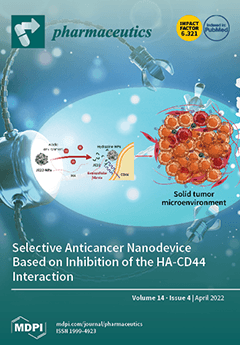Quercetin (QRC) is a bioflavonoid with anti-inflammatory, antioxidant, and anticancer activities, yet QRC poor bioavailability has hampered its clinical implementation. The aim of the current work was to harness novasomes (NOVs), free fatty acid enriched vesicles, as a novel nano-cargo for felicitous QRC
[...] Read more.
Quercetin (QRC) is a bioflavonoid with anti-inflammatory, antioxidant, and anticancer activities, yet QRC poor bioavailability has hampered its clinical implementation. The aim of the current work was to harness novasomes (NOVs), free fatty acid enriched vesicles, as a novel nano-cargo for felicitous QRC delivery with subsequent functionalization with selenium (SeNOVs), to extend the systemic bio-fate of NOVs and potentiate QRC anticancer efficacy through the synergy with selenium. QRC-NOVs were primed embedding oleic acid, Brij 35, and cholesterol adopting thin-film hydration technique according to Box–Behnken design. Employing Design-Expert
® software, the impact of formulation variables on NOVs physicochemical characteristics besides the optimum formulation election were explored. Based on the optimal NOVs formulation, QRC-SeNOVs were assembled via electrostatic complexation/in situ reduction method. The MTT cytotoxicity assay of the uncoated, and coated nanovectors versus crude QRC was investigated in human rhabdomyosarcoma (RD) cells. The in vivo pharmacokinetic and biodistribution studies after intravenous administrations of technetium-99m (
99mTc)-labeled QRC-NOVs, QRC-SeNOVs, and QRC-solution were scrutinized in Ehrlich tumor-bearing mice. QRC-NOVs and QRC-SeNOVs disclosed entrapment efficiency of 67.21 and 70.85%, vesicle size of 107.29 and 129.16 nm, ζ potential of −34.71 and −43.25 mV, and accumulatively released 43.26 and 31.30% QRC within 24 h, respectively. Additionally, QRC-SeNOVs manifested a far lower IC
50 of 5.56 μg/mL on RD cells than that of QRC-NOVs (17.63 μg/mL) and crude QRC (38.71 μg/mL). Moreover, the biodistribution study elicited higher preferential uptake of
99mTc-QRC-SeNOVs within the tumorous tissues by 1.73- and 5.67-fold as compared to
99mTc-QRC-NOVs and
99mTc-QRC-solution, respectively. Furthermore, the relative uptake efficiency of
99mTc-QRC-SeNOVs was 5.78, the concentration efficiency was 4.74 and the drug-targeting efficiency was 3.21. Hence, the engineered QRC-SeNOVs could confer an auspicious hybrid nanoparadigm for QRC delivery with fine-tuned pharmacokinetics, and synergized antitumor traits.
Full article






